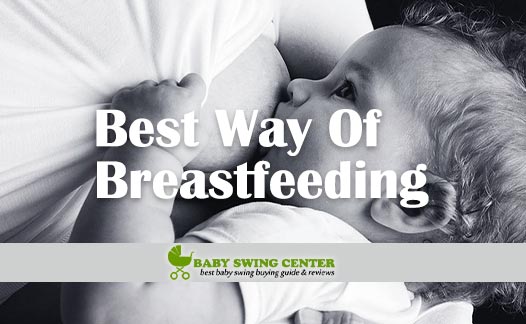One of the most important aspects of taking care of your baby is providing the baby with nutrition. During your pregnancy, you will receive lots of information about the best way to feed your baby and health professionals will usually advise breastfeeding as the best option. If you agree and decide that breastfeeding is right for you and your baby, you may still have questions regarding how you should go about this. Here are some tips for the best way of breastfeeding a baby.

Quick Navigation
- Best Way of Breastfeeding
- Position is Everything
- Sitting Comfortably
- When to Breastfeed
- Drink Water
- Seek Help if Necessary
- Expressing Breast Milk
Best Way of Breastfeeding
Position is Everything
The right position when feeding a baby makes all the difference. If you do not feed in the right position, your baby may struggle to feed; you could potentially get back pain or joint problems, and you run the risk of sore or cracked nipples that may result in an infection called mastitis. There are many good positions that support effective breastfeeding. Each woman will have their own preferred position for breastfeeding. Some will use different positions throughout the day.
Many women prefer the lying position as this is comfortable for them and they feel they can bond with their baby. To try this position, lie on your side on the bed with your head propped on hand. Lie the baby close to you on the bed with your breast exposed. One of the most popular sitting positions is sitting upright and cradling your baby in the crook of your arm. Using a pillow to support your elbow will help to prevent your arm and back aching. Mother position when sitting is called the crook position’. If you are holding the baby to the right breast, use your left arm to support the baby and hold the baby’s head in your hand. Whichever position you choose, it is essential that you bring the baby to the breast, rather than the breast to the baby. This will reduce the likelihood of you suffering pain or discomfort, and the chances of effective breastfeeding are increased.
Sitting Comfortably
As a breastfeeding mom, you will spend long periods of time each day feeding your baby. Therefore, it is essential that you are sat comfortably during each feed. Try not to slouch and use pillows or breastfeeding support cushions to help you support the weight of your baby. This is even more important as your baby grows. If there are things you will need while feeding, put them all next to where you breastfeed so you do not have to disturb the baby or breastfeed while walking.
When to Breastfeed
Mothers who bottle feed are generally encouraged to feed their baby at set times within a routine, gradually increasing the amount of milk given at each feed and leaving longer periods between feeds. Breastfeeding is different and, ideally, you will feed your baby on demand. Your baby will always take enough at each feed to satisfy their needs; whether they are hungry or simply thirsty. However, when your baby stops feeding, it does not necessarily mean they have finished as they may have the wind. Burping your baby at this point before resuming the feed is recommended. There is no need to switch breasts during the same feed. Continuing on the same breast ensures your baby gets the hind milk and this will quench their thirst following the nutritious milk they have already consumed.
Drink Water
Although breastfeeding is a completely natural process, it does draw on the body’s natural reserves. Keeping the body hydrated is important for both the production of milk and your body to function well. Make sure you drink plenty of water throughout the day and keep a glass of water to hand to sip while you are feeding.
Seek Help if Necessary
For many women, breastfeeding a baby is easy. However, some moms find it tougher, especially in the early days. When this happens, they may feel like a failure as they cannot so something’s that seems so natural. This is not the case, and any new mother who feels they need a little support to successfully breastfeed their baby should seek it immediately.
Your doctor, health visitor, midwife, nurse or anyone else involved in the postnatal care of your baby can offer guidance regarding how to breastfeed or point you in the direction of the best support available in your area. Some areas even have a ‘breastfeeding group where new moms can offer each other help and support. This is a great way of making new friends and sharing your experiences of motherhood. Read this Guide to stop breastfeeding a 2 years old baby.
Expressing Breast Milk
For many reasons, a mother may want to skip a feed or stop breastfeeding but still want their baby to benefit from breast milk. Expressing is the ideal solution as it means mom can go out to work or enjoy a night out with friends while her baby still receives all the nutrients and antibodies that breast milk provides. There are several options for expressing milk. The first is to baby either a manual or electronic breast pump. Alternatively, you can express your milk by hand. The health professional leading your postnatal care can show you how to do this.
It is well-known that breastfeeding is the best option for you and your baby as there are benefits for you both. Usually, breastfed babies are fed on demand and finding a comfortable position for feeding will increase the chances of breastfeeding success. If you are finding it difficult to breastfeed your baby, speak to a health professional who can offer the appropriate advice and guidance.I hope you will like the Best Way of Breastfeeding guides.